



a) Documentation provided by FAO
FRA 2000 Terms and definitions (Working Paper 1, Rome 1998)
FRA 2000 Termes et définitions (Document de Travail 1, Rome 1998)
FRA 2000 Guidelines for assessments in tropical and sub-tropical countries (Working Paper 2, Rome 1993)
FRA 2000 Directives pour les evaluations dans les pays tropicaux et sub-tropicaux (Document de travail 2, Rome 1998)
FRA 2000 Directrices para la evaluacion en los paises tropicales y subtropicales (Documento de Trabajo 2, Roma, 1998)
Statistics on non-wood forest products (NWFP) in the Caribbean (country reports)
Pulp and paper capacities, 1998-2003
State of the world's forests, 1999
Situación de los bosques del mundo, 1999
Situation des forêts du monde, 1999
State of the world's forests, 1997
Situación de los bosques del mundo, 1997
Situation des forêts du monde, 1997
FAO, forests and forestry
La FAO, los bosques y la silvicultura
La FAO, les forêts et la foresterie
Non-wood news, March 1999
Unasylva, Vol. 198 "Non wood forest products and income generation"
Unasylva, Vol. 198 "Los productos forestales no madereros y la generación de ingresos"
Unasylva, Vol. 198 "Les produits forestiers non ligneux et la création de revenus"
Forestry statistics today for tomorrow 1945-1993....2010, 1995
FAO Yearbook of forest products, 1997
Productos forestales y energia para el desarrollo rural, Roma, 1993
Non-wood forest products, No. 10 (Tropical palms)
Non-wood forest products, No. 11 (Medicinal plants for forest conservation and healthcare)
Forest topics report No. 5 (Forests, fuels and the future)
Forestry energy forum No. 3 and No 4.
El protocolo de Kyoto y el mechanismo para un desarrollo limpio
Estudio de caso: Electricidad a partir de eucalipto y bagazo en ingenios azucareros de Nicaragua
Guidelines for the management of tropical forests (Forestry Paper No. 135)
Forestry Information Notes (Criteria and Indicators for Sustainable Forest Management)
Socio-economic trends and outlooks: Implications for the Caribbean forestry sector to 2020
FAO country brief on forestry statistics, 16 country briefs
Preliminary country summary information relative to FRA 2000 for the Caribbean. 15 draft summary reports
Developing participatory and integrated watershed management (Community forestry case study series 13)
Monitoring and evaluation of watershed management project achievements (FAO Conservation Guide 24)
Asia-Pacific forestry towards 2010
Global forest products consumption, production, trade and prices: global forest products model projects to 2010
Forestry policies in the Caribbean (Vol. 1: Proceedings of the expert consultation)
Global fibre supply model
Unasylva Vol. 51: Trees outside forests
b) Main wood energy issues to be addressed in the meeting
We assume that:
1) In the case of the Caribbean countries, fuelwood consumption is equivalent to fuelwood production, due to a weak or lack of data on fuelwood import and export.
2) The unit used is PJ (Peta Joules)
3) Haiti, Cuba, Dominican Republic and Jamaica are the main consumers of fuelwood and charcoal in the Caribbean region.
4) Main sources of information are FAOSTAT and OLADE.
· For Trinidad and Tobago and Belize, FAOSTAT is the only source of information.
· For Cuba, Haiti and Jamaica, OLADE is the only source of information.
· For Dominican Republic, Guyana and Suriname, both FAOSTAT and OLADE has been used.
*All the data on import and export for all countries, where available, is from FAOSTAT.
**For some of the remaining countries the information is only partly available, e.g. data exists only on import but not on export or on production.
5) In the WEIS (Wood Energy Information System) Belize, Guyana and Suriname are considered within Latin America Region. However, in this case, we have included them in the Caribbean.
APPENDIX III - FAO INPUTS (CONT.)
c) The development of a forestry statistical service
Objective of Forestry Information
The main objective of forestry statistics is to provide information for effective decision-making or policy and planning towards as well as monitoring progress of sustainable forest management. This can be achieved by:
collecting the highest quality and most useful data possible;
collecting data in a timely and cost effective manner;
producing the most relevant and accessible data products;
informing and training potential data users of benefits and methods of using the available statistical information for more effective decision-making.
The provision of the necessary information for sustainable forest management generally entails the following steps or information cycle:
1. identification of problems and related-information needed to adequately address them;
2. collection of the information;
3. processing of the information;
4. production and dissemination of information products;
5. utilisation by users (policy makers, private sector, NGOs, etc.);
6. improvement of current information, including new information needs, through feedbacks from users.
Examples of forestry information
Most of the information about forestry compiled by FAO falls broadly into two areas:
forest product information, including information and statistics on the production (including capacity), consumption, trade and utilisation of forest products; and
forest resource information, including information and statistics on the area, stocking, growth, condition and type of forest resources in countries.
In addition to this, FAO also compiles quite a wide range of other miscellaneous forestry information about biological and technical parameters, policy and institutional developments and social, economic and environmental factors related to the forestry sector, which complements and helps with the interpretation and analysis of the above information.
An underlying aim of much of the statistical work carried-out by FAO is to ensure that common standards and definitions are used for all international forestry statistics such that accurate comparisons can be made between different data sources, countries, regions and years. Most of the statistics compiled are therefore, produced in a standardised format by all countries in the world. However, the countries of the ECE Region (all countries of Europe; the former USSR; United States of America; Canada and Israel) currently produce and supply a larger and more detailed set of statistics than the countries in other regions.
The frequency and level of detail at which information is compiled varies depending on the type of information (see Box 1). Particular attention is given to the amount of work required to collect each type of information, the demand for recent information on each subject, the speed and amount by which information is likely to change over time and the importance of the subject.
Box 1: Main types of forestry information compiled by the FAO
A wide range of information about forestry is compiled by FAO. Most of the product data is compiled by the Forestry Policy and Planning Division and the resource data by the Forest Resources Division. The Forest Products Division compiles information on NWFP production and forest supply capability and supplements the currently weak information compiled about fuelwood production. The main types of forestry information compiled by FAO and details about how they are compiled are listed below. | ||
Type of information compiled |
Methodology |
Frequency |
Industrial forest product production |
Questionnaire |
Annual |
Fuelwood production |
Questionnaire and desk study |
Annual |
NWFP production and trade |
Desk study |
Continuous |
Forest product trade |
Questionnaire and desk study |
Annual |
Forest product directions of trade |
Questionnaire and desk study |
Annual |
Forest product prices |
Questionnaire and desk study |
Annual |
Pulp and paper capacity |
Questionnaire |
Annual |
Wood based panels capacity |
Questionnaire |
Every 3 years1 |
Forest production/supply potential |
Questionnaire and desk study |
Ad-hoc |
Land use data (including forest area2) |
Questionnaire |
Annual |
Forest resources |
Questionnaire, remote sensing, data modelling and desk study |
Every 10 years3 |
Forest fires (ECE) Forest fires (global) |
Questionnaire Desk study |
Annual Ad-hoc4 |
Plantation resources |
Questionnaire and desk study |
Continuous |
Forest management/use/ownership |
Desk study |
Ad-hoc |
Forest policies and institutions |
Desk study |
Ad-hoc |
Note: 1. Not collected since 1990.
2. Not presented since 1994 - collected by FAO Economic and Social Department.
3. Stored on the FORIS database, which is continuously updated as new information becomes available.
4. From 1981 - 1992, reviewed and recommenced in 1997.
Some information is compiled on an annual basis, including information on land-use in countries, most of the production and trade statistics and some forest resource statistics. This information is usually collected by means of questionnaires sent to all countries of the world and, in this respect, depends heavily on the cooperation and capacity of countries to supply timely and accurate information. Of this information, the forest product production and trade statistics are probably the most complete and reliable data set and the annual surveys used to compile this data elicit the most responses from countries.
New global framework for forest product data collection and analysis
Since UNCED and the work of IFF in particular, the demand for more and reliable information on forest use and conservation has rapidly increased at global, regional, national or local level. The collection, processing and analysis of forest information is costly and there is a need to rationalise its process. With this objective in mind, representatives of FAO, the UN Economic Commission for Europe (ECE), Eurostat and ITTO met in September 1998 and January 1999 with a view to producing a joint Forest Sector Questionnaire (FSQ) in response to requests from member states to rationalise data collection, processing and dissemination.
The advantages of the joint questionnaire are manifold:
each item of information is requested only once from each country;
the filled joint questionnaire is distributed to all four organizations avoiding duplication of efforts;
each individual organization continues to use the information received according to its own mandate;
there is only one national focal point for forest sector statistics in each country who fills in one questionnaire which is sent to one focal organization;
the filled in questionnaire is distributed to other partner organizations;
each partner organization limits its data validation effort to a limited number of countries.
The FSQ is available in electronic form at the following internet address:
ftp://ext-ftp.fao.org/pub/jq/FSQ.htm
Uniform country and product codes are used in the joint questionnaire. All terms and definitions have been harmonised and cross-referenced to the Customs Cooperation Council Harmonised System of 1996 and the UN Standard International Trade Classification (SITC rev. 3 Jan. '98). Participants are encouraged to acquaint themselves with the new definitions and make comments and suggestions for its improvement.
APPENDIX III - FAO INPUTS (CONT.)
d) Towards a harmonised definition of Non-Wood Forest Products
Over the past two decades an increasing number of governmental and non-governmental organizations, institutions, as well as the private sector, have become involved with the promotion and utilisation of Non-Wood Forest Products (NWFP). A lot of new information has been collected on the socio-economic importance and potential of NWFP utilisation and its effects on the environment. However, little progress has been made to clarify the terminology of NWFP and their related terms. On the contrary, new, (more or less) interchangeable terms have been created1, and a multitude of definitions has been proposed, all covering different aspects, species and products according to the focus of work of the respective author/organization. This lack of a clear terminology causes serious problems:
· communication is becoming more problematic, since people are using the same term with different definitions, or without providing any definition at all;
· the comparability of studies and statistics is often non-existent, due to the different definitions and classifications used, in which some products are included, while others are excluded;
· a comprehensive and consistent classification system on NWFP is still missing. Such a system can only be based on an agreed terminology including clear definitions. The existence of definitions and classifications are a crucial element in order to improve the availability of statistical data.
In 1995, FAO made a first step towards a harmonised definition of NWFP by organising the "International Expert Consultation on Non-Wood Forest Products", hosted by the Indonesian Ministry of Forestry. During this meeting, 120 participants from 26 countries, NGOs and UN Agencies agreed on one definition of NWFP.2 This definition has currently been reconsidered within FAO, in order to evaluate the experiences made by applying this definition during the last years, as well as to review the general discussion on terminology related to NWFP. The discussion will lead to a harmonised terminology used within FAO, and will contribute to a general agreement on a global definition of NWFP.
Based on the recommendations of an internal and interdepartmental FAO meeting on definitions of NWFP, the following new FAO working definition of NWFP was agreed upon:
Non-Wood Forest Products consist of goods of biological origin other than wood,
derived from forests, other wooded land and trees outside forest.
This definition, slightly changed in comparison with the one adopted in Yogyakarta 1995, consists, as well as the term NWFP itself, of three essential aspects:
1. Non-wood: The term NWFP excludes all woody raw materials. Consequently, timber, chips, charcoal, fuelwood, as well as small woods such as tools, household equipment and carvings, are excluded.3
2. Forest: NWFP should be derived from forests and similar land uses. FAO has elaborated a definition of "forest" and "other wooded land" (FAO 1998). Since plantations are included in the FAO definition of forest, NWFP which are obtained from plantations, such as gum arabic (Acacia senegal) or rubber (Hevea brasiliensis), are thus also considered. In addition, it has to be taken into consideration that a lot of NWFP are derived from both natural forests and plantations. The final definition of "trees outside forests" (including trees originating from forests which are located out of the forest and other wooded land, such as Acacia albida and the Karité tree Butyspermum parkii) is still in the process of elaboration.
3. Products: In the proposed definition, the term product corresponds to goods, which are tangible and physical objects of biological origin such as plants, animals and their products. Forest services (e.g. ecotourism, grazing, bioprospection), as well as forest benefits (e.g. soil conservation, soil fertility, watershed protection), are excluded from the term NWFP. Services and benefits are even more difficult to assess and quantify than NWFP and, due to this, are already excluded in the vast majority of publications dealing with NWFP. A clear definition of forest services and benefits is still lacking.
The new FAO working definition proposes to distinguish clearly between wood and non-wood forest products, as an important basis to build up a future classification system.
FAO welcomes any comments and suggestions on the proposed definition and classification. Please send any remarks to "Non-Wood News", the bulletin of the FAO NWFP Programme ([email protected]).
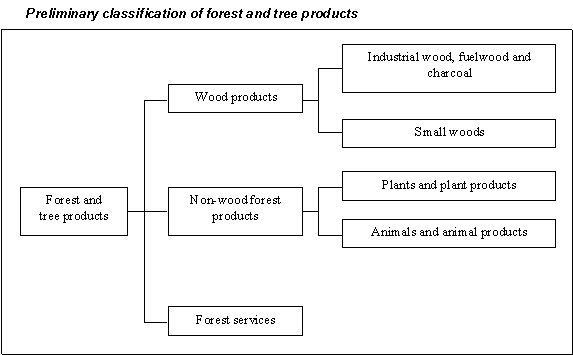
References
FAO. 1995. Report of the International Expert Consultation on Non-Wood Forest Products. Non-Wood Forest Products Series 3. Rome
FAO. 1998. FRA 2000. Terms and Definitions. Forest Resources Assessment Programme, Working Paper 1, Rome
APPENDIX III - FAO INPUTS (CONT.)
e) Discussion Paper on Trees outside Forests -
Tree resources outside forest
With special reference to Caribbean and Latin America
By
FAO - Conservation
Research and Education Service (FORC)
This paper has been prepared to introduce (and update) to the participants in the workshop in Trinidad and Tobago, the Discussion Paper on Trees-outside-forest (TOF) previously presented for the similar workshops in Africa (Mutare, Zimbabwe; Nakuru, Tanzania; Yamassoukro, Côte d'Ivoire). Since the beginning of the project on Data Collection in ACP countries in 1998 and in the framework of its programme on TOF, the FAO Forestry Department has been undertaking a series of activities to take stock of the knowledge on assessment issues of TOF resources. The EC-project in ACP countries (GCP/INT/679/EC), the Forest Resource Assessment (FRA) programme and the Conservation, Research and Education Service (FORC) regular programme, have joined their effort in the process. Studies have been initiated in 15 countries in Africa4, as well as 3 studies in Asia5 and 7 studies in Latin America and Caribbean6. These works aim to get a better understanding of the resources, there classification, the limits and opportunities of the existing methodologies of assessment and, the actors involved in data collection and analysis. Specifically, the studies look at related definitions and terminology adopted legally and/or technically in the countries; ii) the list of the principal resources and their importance according their economic, social and environmental functions; iii) where are found the existing data, and their quality; iv) what are the methodology of assessment, the parameters uses and their quality; v) which institutions are responsible for the assessment of these resources and which actors are involved in their analyses.
The Evaluation & Monitoring Process pass through several steps :
1) identification of the issues and priorities;
2) development of assessment methodology, test and validation;
3) gathering of data;
4) analysis of data, planning;
5) offering a choice of best practices and supporting integration of trees for sustainable rural and urban development;
6) impact assessment and monitoring.
Actually, the GCP/INT/679/EC project focuses specially on steps 1 and 2. Preliminary conclusions of the studies remind that the issue of development of assessment and planning tools posses major methodological problems. It is necessary to develop, test and standardize methodology (methodologies) that will be applicable on a wider scale and relevant even to other countries. The methodologies should be:
· Able to provide a reasonable estimate of the stock, production and economic and other benefits from TOF as also the changes taking place;
· Cost-effective, adaptable and implementable with the limited human resources available and,
· Widely aplicable.
Pilot studies for the development of methodologies of assessment of TOF are currently on -going in Uganda and Zimbabwe. The focus will aim at : i) priorize to the resources to be assessed according to the national issues; ii) develop and validate appropriate methodologies to assess these resources; iii) assess the needs for institutional capacity building. The approach will build on a collaborative effort between the forestry institutions and other concerned actors in order to take into consideration the different roles and responsibilities toward a sustainable forest management and a multifunctional agricultural and land management.
These pilot studies will provide an opportunity, as an initial step, to:
· Discuss with various stakeholders and in particular policy makers and identify the main economic, social and technical issues relevant to policy making and planning relating to cultivation, management and utilization of trees-outside-forest resources;
· Identify the information/data requirements in relation to the issues to facilitate the decision-making process;
· Undertake a detailed review of the available literature relating to methodologies for data collection and analysis in relation to the information needs identified earlier;
· Assess the relevance / application of the methodologies in the context of the national situation, especially taking into account the need for decentralised planning;
· Propose preliminary methodologies that are technically appropriate and operationally feasible to deal with the different issues identifies earlier.
These on-going experiences confirm that information collection related to the trees outside forest is complex and many difficulties to gather and analyze these data are related to the multi-institutional framework of action. In general terms it can be said that a significant part of the trees outside forest are located on farm/agricultural lands, as well as in urban and peri-urban areas. The Discussion Paper present briefly the issues related to the evaluation of these resources. The Annexe I gives the definition of the category Trees-outside-forest and basic terms related to it. As mentioned above, there is preliminary results of studies carried out recently. The Annex II present, in reference to Caribbean and Latin America, the main findings of a study carried out by CATIE for some countries in Latin America (including Haiti).
The Discussion Paper discuss briefly the objectives of the evaluation of trees-outside-forest.
It may be of interest also to note that these data can support the process of valuation of TOF in general. On agricultural lands, for example, it shall support the process to develop options and demonstrate that : "integrating trees on agricultural lands is, comparatively to some agricultural cultures/crops and within specific site conditions, economically viable". If changes are to be achieved for a better integration of trees outside the forests, if the progress of the agricultural frontier (on forest lands) has to be refrain, the end-users of the data (on forest and trees-outside-forest) include managers, policy and decision makers concerned by other sectors (in particular, agricultural sector), as well as the users of TOF resources (e.g. farmers, herders, traders).
Trees outside forest are also founded in urban and peri-urban environment. With the occurring demographic shifts, causing rapid and uncontrolled urbanization in many parts of the developing world, the issue of urban development is likely to become a focal one in the coming decade. Urban forestry has an important potential role in meeting the needs of the urban population and in addressing the social and environmental problems that arise from urbanization. The issues related to the planning, coordination, management and people's participation for an appropriate integration of tree based systems in urban environment shall be addressed along with the issues of rural areas.
FAO and its project GCP/INT/679/EC invite the teams and institutions involved in the process of TOF assessment and planning, as well as in the framework of the pilot studies for the development of assessment methodologies, to encourage strongly a multi-sectorial collaboration in order to plan and monitor the process through "multi-institutional advisory teams". It is hope that it would contribute to better prepare the ground for the further use of the data on Trees-outside-forest as an appropriate tool toward sustainable rural development in general, and sustainable forest management in particular.
APPENDIX III - FAO INPUTS (CONT.)
f) Forestry Sector Outlook Slides
Slide 1
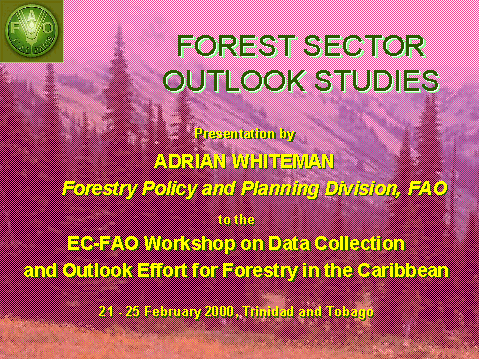
Slide 2

Slide 3
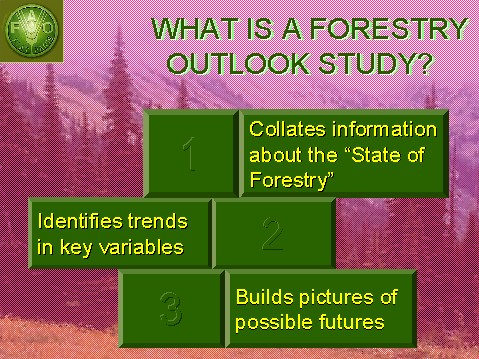
Slide 4

Slide 5
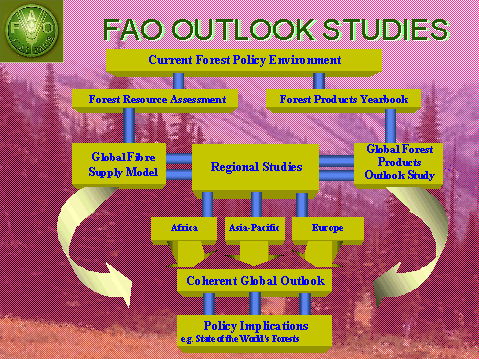
Slide 6
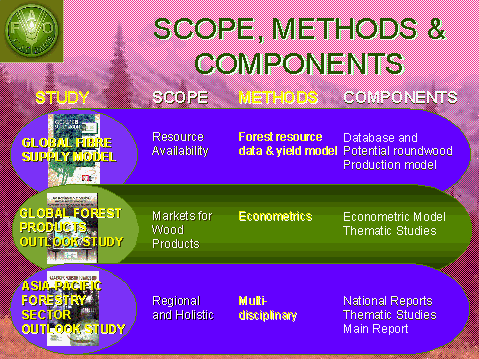
Slide 7
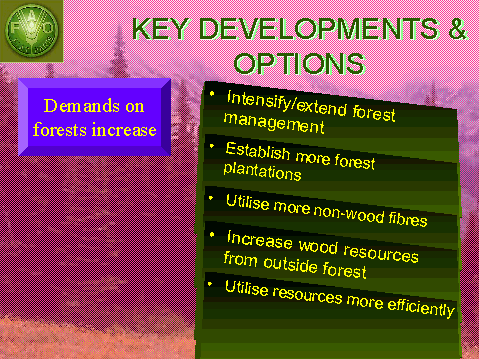
Slide 8
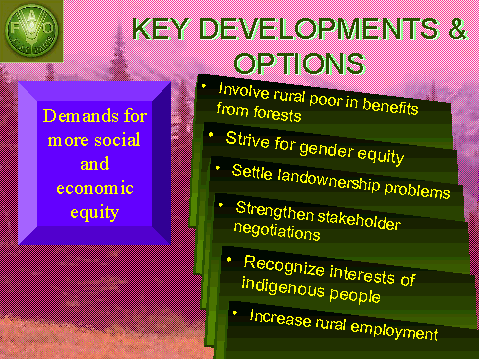
Slide 9

Slide 10
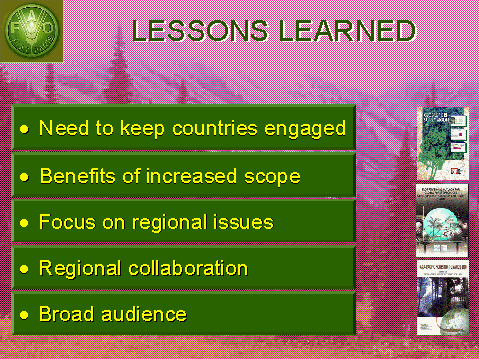
1 By-Products of Forests, Minor Forest Products, Non-Timber Forest Products, Non-Wood Goods and Benefits, Non-Wood Goods and Services, Other Forest Products, Secondary Forest Products, Special Forest Products
2 The following definition was adopted by the meeting: "NWFP consist of goods of biological origin other than wood, as well as services, derived from forests and allied land uses" (FAO 1995).
3 The exclusion of small woods and fuelwood is the main difference between the terms NWFP and Non-Timber Forest Products (NTFP). NTFP in general include fuelwood and small woods.
4 Studies in Africa : Benin, Burundi, Chad, Côte d'Ivoire, Guinea, Mali., Mauritania, Mozambique, Niger, Nigeria, Senegal, South Africa and Uganda (including some information on Djibouti, Eritrea, Ethiopia, Kenya, Somalia, Sudan, Tanzania, Zimbabwe).
5 Asia : Bangladesh, India, Sri Lanka.
6 Latin America and Caribbean : Brazil, Colombia, Costa Rica, Guatemala, Haiti, Honduras and Peru.
